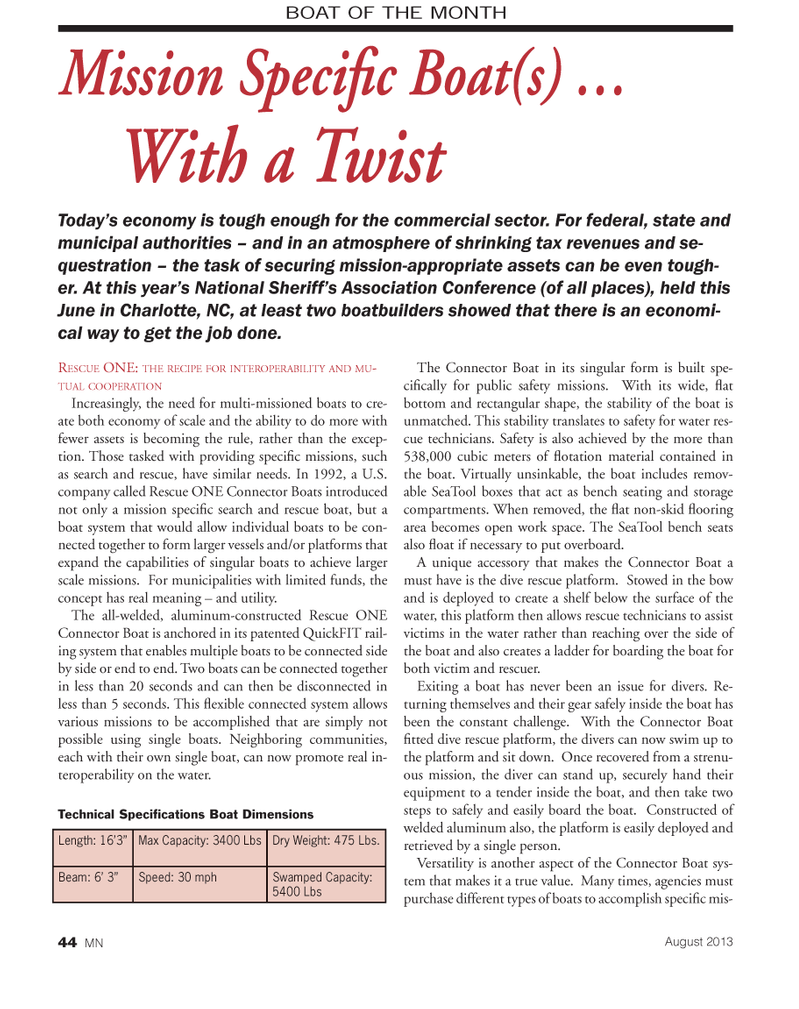
Page 44: of Marine News Magazine (August 2013)
Salvage & Response
Read this page in Pdf, Flash or Html5 edition of August 2013 Marine News Magazine
RESCUE ONE: THE RECIPE FOR INTEROPERABILITY AND MU-TUAL COOPERATION Increasingly, the need for multi-missioned boats to cre- ate both economy of scale and the ability to do more with fewer assets is becoming the rule, rather than the excep- tion. Those tasked with providing speci? c missions, such as search and rescue, have similar needs. In 1992, a U.S. company called Rescue ONE Connector Boats introduced not only a mission speci? c search and rescue boat, but a boat system that would allow individual boats to be con- nected together to form larger vessels and/or platforms that expand the capabilities of singular boats to achieve larger scale missions. For municipalities with limited funds, the concept has real meaning ? and utility. The all-welded, aluminum-constructed Rescue ONE Connector Boat is anchored in its patented QuickFIT rail- ing system that enables multiple boats to be connected side by side or end to end. Two boats can be connected together in less than 20 seconds and can then be disconnected in less than 5 seconds. This ? exible connected system allows various missions to be accomplished that are simply not possible using single boats. Neighboring communities, each with their own single boat, can now promote real in- teroperability on the water. The Connector Boat in its singular form is built spe-ci? cally for public safety missions. With its wide, ? at bottom and rectangular shape, the stability of the boat is unmatched. This stability translates to safety for water res- cue technicians. Safety is also achieved by the more than 538,000 cubic meters of ? otation material contained in the boat. Virtually unsinkable, the boat includes remov- able SeaTool boxes that act as bench seating and storage compartments. When removed, the ? at non-skid ? ooring area becomes open work space. The SeaTool bench seats also ? oat if necessary to put overboard. A unique accessory that makes the Connector Boat a must have is the dive rescue platform. Stowed in the bow and is deployed to create a shelf below the surface of the water, this platform then allows rescue technicians to assist victims in the water rather than reaching over the side of the boat and also creates a ladder for boarding the boat for both victim and rescuer. Exiting a boat has never been an issue for divers. Re- turning themselves and their gear safely inside the boat has been the constant challenge. With the Connector Boat ? tted dive rescue platform, the divers can now swim up to the platform and sit down. Once recovered from a strenu- ous mission, the diver can stand up, securely hand their equipment to a tender inside the boat, and then take two steps to safely and easily board the boat. Constructed of welded aluminum also, the platform is easily deployed and retrieved by a single person. Versatility is another aspect of the Connector Boat sys- tem that makes it a true value. Many times, agencies must purchase different types of boats to accomplish speci? c mis- Mission Speci? c Boat(s) ? Mission Speci? c Boat(s) ? With a Twist Today?s economy is tough enough for the commercial sector. For federal, state and municipal authorities ? and in an atmosphere of shrinking tax revenues and se- questration ? the task of securing mission-appropriate assets can be even tough- er. At this year?s National Sheriff?s Association Conference (of all places), held this June in Charlotte, NC, at least two boatbuilders showed that there is an economi- cal way to get the job done. Length: 163? Max Capacity: 3400 Lbs Dry Weight: 475 Lbs. Beam: 6 3? Speed: 30 mphSwamped Capacity: 5400 Lbs Technical Speci? cations Boat Dimensions BOAT OF THE MONTH 44 MNAugust 2013MN August2013 Layout 32-49.indd 447/23/2013 7:27:58 PM

 43
43

 45
45
